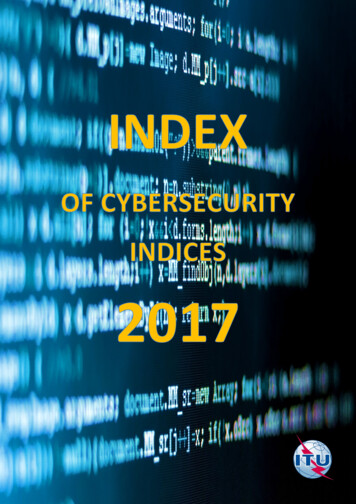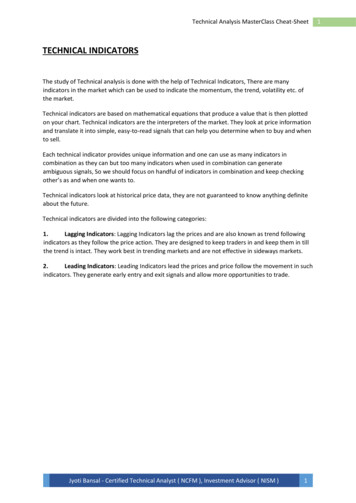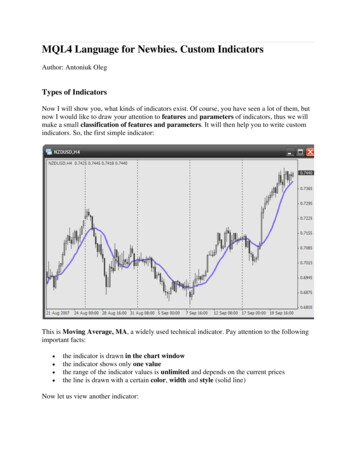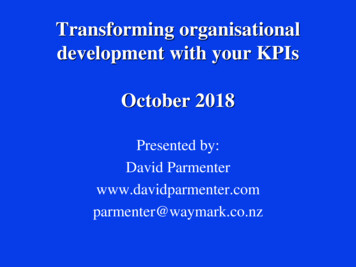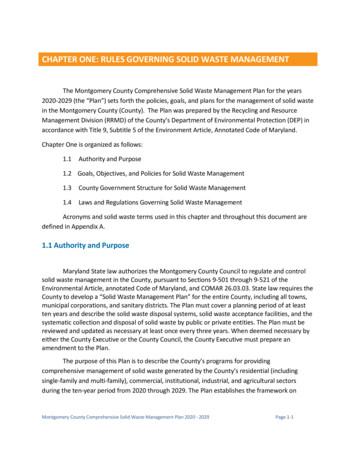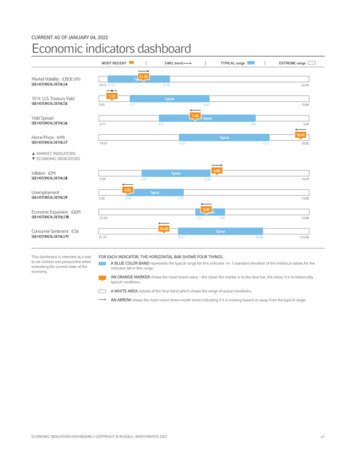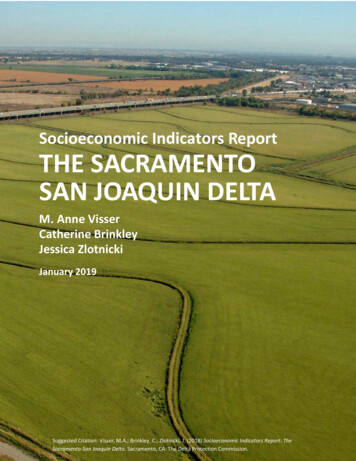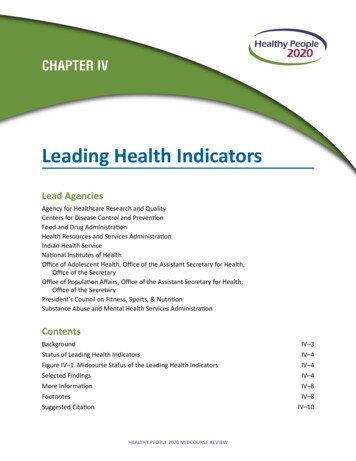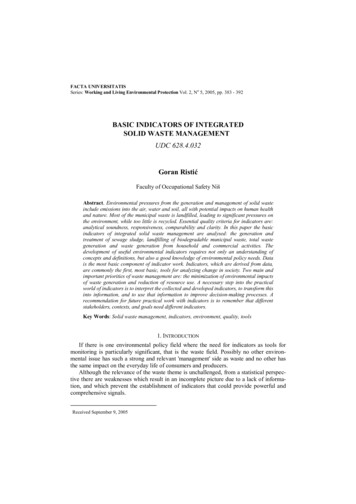
Transcription
FACTA UNIVERSITATISSeries: Working and Living Environmental Protection Vol. 2, No 5, 2005, pp. 383 - 392BASIC INDICATORS OF INTEGRATEDSOLID WASTE MANAGEMENTUDC 628.4.032Goran RistićFaculty of Occupational Safety NišAbstract. Environmental pressures from the generation and management of solid wasteinclude emissions into the air, water and soil, all with potential impacts on human healthand nature. Most of the municipal waste is landfilled, leading to significant pressures onthe environment, while too little is recycled. Essential quality criteria for indicators are:analytical soundness, responsiveness, comparability and clarity. In this paper the basicindicators of integrated solid waste management are analysed: the generation andtreatment of sewage sludge, landfilling of biodegradable municipal waste, total wastegeneration and waste generation from household and commercial activities. Thedevelopment of useful environmental indicators requires not only an understanding ofconcepts and definitions, but also a good knowledge of environmental policy needs. Datais the most basic component of indicator work. Indicators, which are derived from data,are commonly the first, most basic, tools for analyzing change in society. Two main andimportant priorities of waste management are: the minimization of environmental impactsof waste generation and reduction of resource use. A necessary step into the practicalworld of indicators is to interpret the collected and developed indicators, to transform thisinto information, and to use that information to improve decision-making processes. Arecommendation for future practical work with indicators is to remember that differentstakeholders, contexts, and goals need different indicators.Key Words: Solid waste management, indicators, environment, quality, tools1. INTRODUCTIONIf there is one environmental policy field where the need for indicators as tools formonitoring is particularly significant, that is the waste field. Possibly no other environmental issue has such a strong and relevant 'management' side as waste and no other hasthe same impact on the everyday life of consumers and producers.Although the relevance of the waste theme is unchallenged, from a statistical perspective there are weaknesses which result in an incomplete picture due to a lack of information, and which prevent the establishment of indicators that could provide powerful andcomprehensive signals.Received September 9, 2005
384G. RISTIĆ2. INTEGRATED SOLID WASTE MANAGEMENTThe more civilisation advances, the more problems with solid waste managementarise. Permanent handling of the increasing and more and more hazardous quantities ofsolid waste materials is becoming a dominant global issue. Each waste material quantity,even the most minor one, and its uncontrollable return to nature, represents handing downone and the same problem to generations yet to come. A far more complex problem issolid waste management in urban areas.For most of us, waste is the bags of household rubbish that leave our households everyweek. We know that it 'goes somewhere' – but few have actually seen a landfill site, awaste incineration plant, or a recycling centre, and most of us do not give it much thought.Waste is generated by activities in all economic sectors and is generally regarded as anunavoidable by-product of economic activity (waste generated from inefficient productionprocesses, the low durability of goods and unsustainable consumption patterns). The generation of waste reflects a loss of materials and energy and imposes economic and environmental costs on a society for its collection, treatment and disposal. Waste forms anincreasing part of the total material flow through the economy and is increasingly beingconsidered in the context of material flows as a whole.Environmental pressures from the generation and management of waste include emissions into the air (including greenhouse gases), water and soil, all with potential impactson human health and nature. Most of the municipal waste is landfilled, leading to significant pressures on the environment, while too little is wmaterialsEnergyProductmanufactureEmissions& & WasteDisposal/RecoveryEmissions& ionProduct useFig. 1. Waste flows (Source: Irish Environmental Protection Agency)An integral system of solid waste management is based on the analysis, discussion anddefining of the methods and procedures of solid waste treatment. The initial point is thepossibility of its reduction, choosing the optimal ways of its treatment starting from its
Basic Indicators of Integrated Solid Waste Management385creation to its final handling and its transformation into something safe for the environment and the well-being of people.Conception of solid waste management in an integral system consists of four mainprinciples: Avoid as long as possible Use as much as possible Technically redo as much as needed Dispose of as little as possibleFinally and most importantly waste generation is still linked to economic activity,meaning that, as economy grows, the waste problem will grow with it.3. ENVIRONMENTAL INDICATORSIndicators have been used for a long time as a tool with which more information canbe obtained about issues as varied as people's health, weather, and economic welfare.Compared to indicators of economic and social aspects, environmental and sustainabledevelopment indicators are a relatively new phenomenon. The Rio Conference on Environment and Development in 1992, and other similar environmental milestone activitiesand happenings, recognized the need for better and more extensive knowledge and information about environmental conditions, trends, and impacts. To achieve this, it was notonly necessary to collect new and better data; new thoughts and research with regard toindicator frameworks, methodologies, and actual indicators were also needed.Over the past few years, there has been an increased interest in and work on the use ofindicators to monitor change. The development of useful environmental indicators requires not only an understanding of concepts and definitions, but also a good knowledgeof policy needs. In fact, the key determinant of a good indicator is the link from measurement of some environmental conditions to practical policy options.Environmental indicators can be used at both international and national levels as a toolfor state-of-the-environment reporting, measuring environmental performance, and reporting on progress toward sustainable development. At the national level they can alsobe used for clarifying objectives and setting priorities.In working with indicators, there are several terms that figure frequently. The mostcommon ones are data, indicator, index and information. These are terms that mean different things in different contexts and for different research.Data is the most basic component of indicator work. As such, it is the basis for indicators, indices and information. Most data can not be used to interpret change in the stateof the environment, the economy or the social aspects of society.Indicators, which are derived from data, are commonly the first, most basic, tools foranalyzing change in society. Indicators are superior data as an analytical tool for severalreasons. Firstly, they can work as a basis for assessment by providing information on conditions and trends of sustainable development. Secondly, as a basis of such assessments,indicators can provide input to policy formulation processes. Thirdly, by presenting several data in one number that commonly is easier to interpret than complex statistics, theycan facilitate communication between different groups, for example between experts andnon-experts.
386G. RISTIĆIf two or more indicators, alternatively several kinds of data, are combined, an index iscreated. Indices are commonly used at more aggregated analytical levels such as at thenational or regional level. At these levels it may not be easy to analyze the causal linksusing individual indicators since the relationships between different indicators becomemore and more complex the more aggregate the analytical level is. However, there areproblems with computing indices as well. For example, sustainable development indicesare extremely complex. Indices that cover issues from one and the same sector, or aspect,are thus more common.IndicesIndicesINDICATORSAnalyzed dataINDICATORSAnalyzed dataPrimarydataPrimary dataA - TheoryB - RealityFig. 2. The Information Pyramid (Source: The World Bank Environment Department)The lack of data in general and reliable data specifically, is a common problem in theindicator world. This is true for most indicator initiatives at most analytical levels. Due toits relative infancy, environmental data is difficult to come by compared to data for economic and social indicators. The theory behind the development of indicators and indiceslooks like Figure 2A, with a broad base of good quality primary data on which the indicators and indices can rest on. To show a simplified picture of reality, this informationpyramid is commonly turned upside down (Figure 2B) with many indices developed usingthe same, limited data sets that currently exist. As is discussed below, this should anddoes not necessarily hinder and discourage the development of indicators today, but thefigure clearly illustrates the need for new and improved environmental data. While theproblem of data availability and quality can be relatively easily solved at the project levelthrough the inclusion of a data collection component, it is commonly a bigger problem atthe national or regional level, considering the costs involved in collecting new data for awhole country or region.4. INDICATORS OF INTEGRATED SOLID WASTE MANAGEMENTFrom a policy perspective, there are two main – and important – orientations that canbe identified in line with the best general strategy on waste and the priorities of wastemanagement operations: The minimization of environmental impacts of waste generation, with the overall objective of reducing (and finally preventing) waste generation. The reduction of resource use and the related task of successful implementation ofappropriate waste management policies, with complete or partial recovery or recy-
Basic Indicators of Integrated Solid Waste Management387cling of materials. The objective is to maximize 'recovery, reuse and recycling' operations (RRR) in order to achieve sustainable waste management.The five essential quality criteria for indicators – also applicable to the waste domain– have to be highlighted: Analytical soundness (the correlation between changes in the indicator and changesin environmental pressure and/or use of resources), Responsiveness (the capacity of the indicator to reflect and respond to policy actions), Comparability of the used data Consistency with other related indicators (a consistent set) and, last but not least, Clarity, meaning the capacity to be easily understood.Table 1. Basic indicators of integrated solid waste managementIndicatorGeneration andtreatment of sewagesludgePolicy IssueAre we disposing of thegrowing stream of sewagesludge in an environmentallyfriendly way?AssesmentThe amount of sewage sludge fordisposal in landfills is expected toincrease by 50% by 2005.Too much biodegradable waste is stillProgress towards Directivebeing landfilled. In countries that maketarget on landfilling ofmost use of landfill to dispose of theirbiodegradable municipal wastewaste, no improvement has happened.The limited information availableIs creating less waste, and isindicates that total waste generation isTotal waste generation waste generation still tied toincreasing.economic growth?Target for municipal and householdWaste generation from Are we on course for meetingwaste was not met - and is unlikely to betargets for municipal andhousehold andmet in the future if current trends are notcommercial activities household waste generation?reversed.Landfilling ofbiodegradablemunicipal waste4.1 Generation and treatment of sewage sludgeSewage sludge is the waste left over after wastewater treatment plants have done theirwork. Although it can be a valuable fertilizer, it is often contaminated by heavy metals,micro-organisms and a range of hazardous organic substances. As a result, in 1998 some25% of sewage sludge was dumped in landfill sites.The more severe demands for treatment in the Directive on Urban Waste WaterTreatment will result in many new treatment plants coming into operation by 2005. Thetotal amount of sewage sludge is expected to increase from 7.2 million tons of dry matterin 1998 to at least 9.4 million tons in 2005.In 2005, the percentage dumped in landfills is expected to fall to 19%, fertilizer usewill rise slightly (54%), and disposal by incineration will grow significantly (24%).Currently, for example, the EU is considering tightening the limits on the contamination levels allowed in sewage sludge used for fertilizer, with some countries alreadyadopting lower levels. Tighter limits will increase costs – it costs over five times more toincinerate sludge than to use it as a fertilizer – thereby possibly increasing the quantity ofsludge sent to landfill instead.
388G. RISTIĆReducing the contamination levels in sludge, therefore, would both reduce landfilling,pollution, and costs in the sector.Fig. 3. Treatment of sewage sludge: selected EEA member countries, 1998 (Source: EEA)4.2 Landfilling of biodegradable municipal wasteAs biodegradable waste decomposes in landfills, it produces greenhouse gases andleaves behind potentially toxic liquids which can escape the landfill and pollute the surrounding environment. Adopting alternatives, such as composting and reusing the wasteor burning it to generate energy, would therefore reduce both pollution and the amount ofland devoted to waste disposal.The best data is from 1995, when the EU and Norway, for example, produced around 107million tons of biodegradable municipal waste (BMW), two thirds of which were landfilled.As the Figure shows, many of the countries, which landfilled a significant proportionof their BMW in 1995, including the United Kingdom, Ireland and Finland, now landfillFig. 4. Biodegradable municipal waste landfilled as a percentage of a total generation ofbiodegradable municipal waste, 1995–1998 (Source: EEA)
Basic Indicators of Integrated Solid Waste Management389even more. On the other hand, a certain number of countries actually reduced their proportion of landfilled BMW, including the Netherlands, Norway, Italy, and the Flemishregion of Belgium.The Directive on the Landfill of Waste sets targets for 2006, 2009, and 2016. Reaching them will require both reducing the fraction of BMW which is landfilled and reducingthe total amount of BMW produced in the first place. This, in turn, will mean improvingthe collection of BMW, allowing it to be separated according to how contaminated it is,and creating new markets and outlets for BMW materials to be diverted away from landfills.4.3 Total waste generationEU generates around 1.3 billion tons of waste every year. The data also shows thatwaste generation is still coupled to economic growth, making it impossible to pursue economic growth without generating increasingly serious waste management problems.There is a particularly close link between economic growth and waste from the construction industry. As the Figure shows, this sector is responsible for around a fifth of allwaste, while the largest sources are the manufacturing and mining/quarrying sectors.Fig. 5. Index for total waste generation1995 to 1998(Source: Eurostat, EEA specific waste streams)Fig. 6. Total waste generation by sector– EEA Countries 1992-1997(Source: Eurostat, EEAspecific waste streams)4.4 Waste generation from household and commercial activitiesDaily household and commercial activities generated around 400 kg of waste per person in 1996. This included both mixed household rubbish and separately collected wastesuch as paper and glass.The EU's 2000 target for municipal waste, mentioned in the 5th Environmental ActionProgramme, was 300 kg per person per year. Municipal waste, however, is a broaderterm, including much more than household and commercial activity waste. Factor in thetrend towards increased waste generation since 1996, and it becomes clear that the 300 kglimit will not be reached without significant cuts in household waste generation.
390G. RISTIĆFig. 7. Waste generation from daily household and commercial activities (Source: EEA)The variations in the waste generated from daily household and commercial activitiesbetween member countries are small, except for Austria and Iceland, which have considerably less than average waste generation. The correlation between private consumptionand the waste generated from daily household and commercial activities does not exist;the level of generation is less dependent on income than on differences between membercountries.5. INSTEAD OF A CONCLUSION - FUTURE ACTIVITIESWork on environmental and sustainable development indicators has, in many ways,come a long way in a few years' time. However, as always when a new area of research is"discovered" and pursued, some aspects of the work have come much further than others.Considering the diversity of contexts, issues, circumstances, and conditions that are relevant when monitoring the environment, it may not be feasible to develop a frameworkbetter than the existing ones. Indicators are all about indicating a change or direction indevelopment, not about providing the complete answer. In the same manner, indicatorsshould be used as an instrument to achieve higher ends, the instruments commonly relatedto indicator development should be used as effectively as possible. Here, the lessonlearned is: be flexible.The link between cause and effect is still a mystery in many analyses. While indicatorscan be used to understand this link, many initiatives today seem to assume causal linksthat may or may not exist. In many cases, it is also difficult to establish the links clearly.The same analytical problems are often encountered in other types of initiatives where thepurpose of the indicators is to see how one action leads, or does not lead, to an observableimpact. More research on causal links is clearly needed, and indicators could be used in amore explicit way in that research.
Basic Indicators of Integrated Solid Waste Management391There are groups of indicator initiatives that need more focus in the future, such asthose that emphasize gaps in existing indicator sets of environmental aspects, includingindicators of institutional development, biodiversity and various cross-cutting issues.For many years, the concept of sustainable development has in many publications andcontexts been used almost as a synonym to environmental sustainability or change. Indicators could potentially play an important role in widening the concept again to comprisesocial, economic, and environmental issues in interplay. One suggestion for future activities could therefore be to focus more on the interlinkages between social, economic andenvironmental aspects, that is, to analyze the linkages between those aspects in the indicator initiatives which encompass indicators of all three sorts. An analysis of the interlinkages puts the issue of sustainability in the center.The largest gaps in current indicator work probably consist of the practical challengesthat still need to be met and solved. One of these gaps has been stressed before, but isworth repeating - data collection and quality assurance - are among the largest challengesthat indicator developers face.A necessary step into the practical world of indicators is to interpret the collected anddeveloped indicators, to transform this into information, and to use that information to improve decision-making processes. Analytical examples of indicator and information usecould be performed at any level of analysis in basically any context and could still contributewith several helpful hints for practical solutions on how to achieve the greatest results.A final lesson learned and recommendation for future practical work with indicators isto remember that different audiences, contexts, and ends need different indicators. Targetgroups for the indicator initiatives are seldom discussed explicitly. There are risks thatresult from the aim to identify conceptual frameworks, indicators, and analytical/presentational tools that are relevant to all different categories of audiences. Such anaim commonly fails in reaching several target groups, and one is often better off designing different indicator initiatives for different target groups. Therefore, make sure youknow your target group, why they wish to use indicators and for what purpose, beforedeciding on the framework, indicators, and analytical and presentational tools.REFERENCES1. Adriaanse, A., Bringezu, S., Hammond, A., Moriguchi, Y., Rodenburg, E., Rogich, D. & Schütz, H."Resource Flows: The Material Basis of Industrial Economies", World Resources Institute: Washington,USA; 1997.2. Bossel, H. "Indicators for Sustainable Development: Theory, Method, Applications". International Institute for Sustainable Development: Winnipeg, Canada. 1999.3. European Commission -Eurostat, "Measuring Progress Towards a More Sustainable Europe ProposedIndicators for Sustainable Development", Luxembourg 2001.4. OECD (Organization for Economic Co-operation and Development). "Environmental Indicators".OECD: Paris, France. 1994.5. OECD, "Towards Sustainable Development - Indicators to Measure Progress - Session IIB Environmental Performance Indicators", OECD, 1999.6. OECD, "Frameworks to Measure Sustainable Development", OECD Paris 2000.7. Segnestam, L. "Environmental Performance Indicators". Environment Department Papers No. 71. TheWorld Bank: Washington, USA. 1999.8. United Nation Commission on Sustainable Development, "Indicators of Sustainable Development:Framework and Methodologies, New York, 2001.9. WRI (World Resources Institute). "Developing environmental indicators". 2000. (www.wri.org)
392G. RISTIĆOSNOVNI INDIKATORI INTEGRALNOG MENADŽMENTAČVRSTIM OTPADOMGoran RistićNastajanje i menadžment čvrstim otpadom vrši "pritisak" na životnu sredinu emisijom u vazduh ivodu i zagadjivanjem zemljišta, sa značajnim potencijalnim uticajima na zdtavlje ljudi i prirodu.Većina komunalnog otpada se deponuje, sa značajnim "pritiskom" na životnu sredinu, dok se veomamali deo reciklira. Najznačajniji kriterijumi kvaliteta indikatora su: analitička zasnovanost, osetljivost,komparabilnost-uporedivost i jasnost. U ovom radu analizirani su osnovni indikatori integralnogmenadžmenta čvrstim otpadom: nastajanje i tretman otpadnog mulja, deponovanje biodegradabilnogkomunalnog otpada, ukupna produkcija otpada i produkcija otpada iz domaćinstava i komercijalnihaktivnosti. Razvoj upotrebljivih indikatora životne sredine zahteva razumevanje ne samo koncepta idefinicija, već i dobro poznavanje zahteva politike zaštite životne sredine. Podaci su osnovnakomponenta indikatora. Indikator, izveden iz podataka, je opšti i osnovni alat za analizu promena udrustvu. Dva osnovna i najznačajnija prioriteta menadžmena čvrstim otpadom su: minimizacijauticaja nastajanja otpada na životnu sredinu i redukcija korišćenja resursa. Neophodni korak uprakticnoj primeni indikatora je tumačenje prikupljenih i razvijenih indikatora, njihova transformacija uinformacije i korišćenje informacija za poboljšanje procesa donošenja odluka. Preporuka za budućepraktične aktivnosti u vezi sa indikatorima je zapamtiti da različite zainteresovane grupe, konteksti iciljevi zahtevaju različite indikatore.Ključne reči: Menadžment čvrstim otpadom, indikatori, životna sredina, kvalitet, alati
SOLID WASTE MANAGEMENT UDC 628.4.032 Goran Ristić Faculty of Occupational Safety Niš Abstract. Environmental pressures from the generation and management of solid waste include emissions into the air, water and soil, all with potential impacts on human health and nature. Most of the municipal waste is landfilled, leading to significant .
